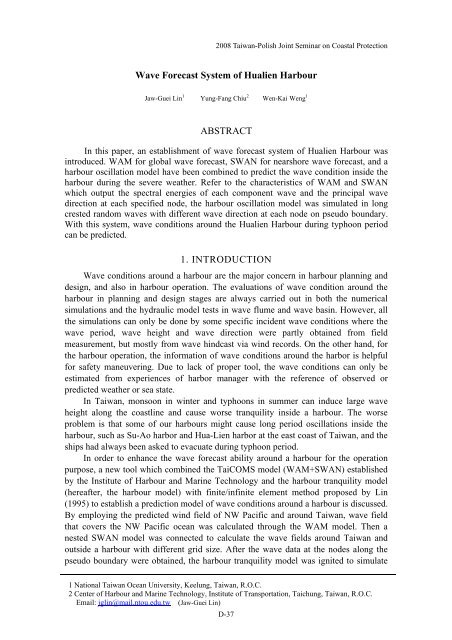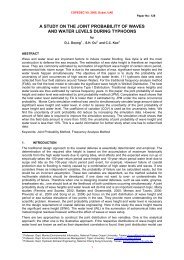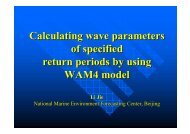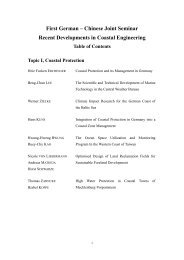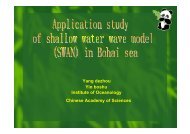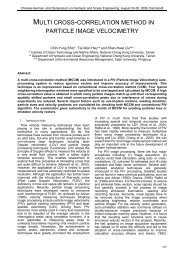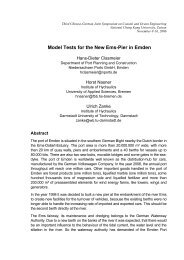D-4 Wave Forecast System of Hualien Harbour by Jaw-Guei Lin ...
D-4 Wave Forecast System of Hualien Harbour by Jaw-Guei Lin ...
D-4 Wave Forecast System of Hualien Harbour by Jaw-Guei Lin ...
Create successful ePaper yourself
Turn your PDF publications into a flip-book with our unique Google optimized e-Paper software.
2008 Taiwan-Polish Joint Seminar on Coastal Protection<strong>Wave</strong> <strong>Forecast</strong> <strong>System</strong> <strong>of</strong> <strong>Hualien</strong> <strong>Harbour</strong><strong>Jaw</strong>-<strong>Guei</strong> <strong>Lin</strong> 1 Yung-Fang Chiu 2 Wen-Kai Weng 1ABSTRACTIn this paper, an establishment <strong>of</strong> wave forecast system <strong>of</strong> <strong>Hualien</strong> <strong>Harbour</strong> wasintroduced. WAM for global wave forecast, SWAN for nearshore wave forecast, and aharbour oscillation model have been combined to predict the wave condition inside theharbour during the severe weather. Refer to the characteristics <strong>of</strong> WAM and SWANwhich output the spectral energies <strong>of</strong> each component wave and the principal wavedirection at each specified node, the harbour oscillation model was simulated in longcrested random waves with different wave direction at each node on pseudo boundary.With this system, wave conditions around the <strong>Hualien</strong> <strong>Harbour</strong> during typhoon periodcan be predicted.1. INTRODUCTION<strong>Wave</strong> conditions around a harbour are the major concern in harbour planning anddesign, and also in harbour operation. The evaluations <strong>of</strong> wave condition around theharbour in planning and design stages are always carried out in both the numericalsimulations and the hydraulic model tests in wave flume and wave basin. However, allthe simulations can only be done <strong>by</strong> some specific incident wave conditions where thewave period, wave height and wave direction were partly obtained from fieldmeasurement, but mostly from wave hindcast via wind records. On the other hand, forthe harbour operation, the information <strong>of</strong> wave conditions around the harbor is helpfulfor safety maneuvering. Due to lack <strong>of</strong> proper tool, the wave conditions can only beestimated from experiences <strong>of</strong> harbor manager with the reference <strong>of</strong> observed orpredicted weather or sea state.In Taiwan, monsoon in winter and typhoons in summer can induce large waveheight along the coastline and cause worse tranquility inside a harbour. The worseproblem is that some <strong>of</strong> our harbours might cause long period oscillations inside theharbour, such as Su-Ao harbor and Hua-Lien harbor at the east coast <strong>of</strong> Taiwan, and theships had always been asked to evacuate during typhoon period.In order to enhance the wave forecast ability around a harbour for the operationpurpose, a new tool which combined the TaiCOMS model (WAM+SWAN) established<strong>by</strong> the Institute <strong>of</strong> <strong>Harbour</strong> and Marine Technology and the harbour tranquility model(hereafter, the harbour model) with finite/infinite element method proposed <strong>by</strong> <strong>Lin</strong>(1995) to establish a prediction model <strong>of</strong> wave conditions around a harbour is discussed.By employing the predicted wind field <strong>of</strong> NW Pacific and around Taiwan, wave fieldthat covers the NW Pacific ocean was calculated through the WAM model. Then anested SWAN model was connected to calculate the wave fields around Taiwan andoutside a harbour with different grid size. After the wave data at the nodes along thepseudo boundary were obtained, the harbour tranquility model was ignited to simulate1 National Taiwan Ocean University, Keelung, Taiwan, R.O.C.2 Center <strong>of</strong> <strong>Harbour</strong> and Marine Technology, Institute <strong>of</strong> Transportation, Taichung, Taiwan, R.O.C.Email: jglin@mail.ntou.edu.tw (<strong>Jaw</strong>-<strong>Guei</strong> <strong>Lin</strong>)D-37
2008 Taiwan-Polish Joint Seminar on Coastal Protectionthe wave condition around the harbour. With such tool, harbour tranquility duringsevere weather can be predicted when the wind fields were analyzed and forecasted.In the following paragraph, we will briefly describe the theory <strong>of</strong> the work, and thepredicted wind fields during the period <strong>of</strong> typhoon Longwang between 2005/09/30 and2005/10/04 was employed for the calculations <strong>of</strong> wave conditions around <strong>Hualien</strong>harbour at the east coast <strong>of</strong> Taiwan as an example.2. TAICOMS WAVE MODELTaiComs (Taiwan Coastal Operational Modeling <strong>System</strong>) is one <strong>of</strong> the wind wavepredictions models around Taiwan area which developed and operated <strong>by</strong> the Center <strong>of</strong><strong>Harbour</strong> and Marine Technology, Institute <strong>of</strong> Transportation for the safety navigationsin Taiwan water zone. As shown in Fig. 1, a WAM and a SWAN models areemployed. Table 1 shows their computational area and their spatial resolutions.The needed wind fields are supported <strong>by</strong> CWB. As shown in Fig. 2, there are threenumerical wind fields, RC, MC and HC, which covers different area with different gridresolutions <strong>of</strong> 0.45°×0.45° , 0.15°×0.15° and 0.05°×0.05°, respectively. The numericaltopography is extracted from either ETOPO5 from NGDC, NOAA (NationalGeographic Data Center, National Oceanic and Atmospheric Administration, USA)with grid resolutions <strong>of</strong> 5’×5’or TaiDBMv5 from National Ocean Science Center,Taiwan with grid resolutions <strong>of</strong> 0.05°×0.05°.TABLE I. RELATED INFORMATION IN TAICOMS MODELType Model Cover area Grid sizeFar fieldNear fieldWAMSWANLat.: 10°N ~ 35°NLon.: 110°E ~ 134°ELat.: 21°N ~ 26°NLon.: 119°E ~ 123°EWindfield0.2°×0.2° RC0.04°×0.04° MCWAMSWANFig1. Computational area and topography in TaiComs ModelD-38
2008 Taiwan-Polish Joint Seminar on Coastal ProtectionRCHCMCFig2. Computational area <strong>of</strong> RC/MC/HC wind fields3. THE HARBOUR TRANQUILITY MODELThe model employed in the study is a finite/infinite element model developed <strong>by</strong><strong>Lin</strong> and Chen(1996)[2], <strong>Lin</strong>(1995)[1] gives the full theory <strong>of</strong> the model. Figure 3 showsthe definition sketch <strong>of</strong> the model. An arbitrary shape and bathymetry harbour isconsidered. The water zone are divided into two domains: Ω1and Ω 2, where Ω1is afinite domain which bounded <strong>by</strong> the solid boundary around the harbour Γ1, free watersurface, sea bottom, and pseudo boundary Γ 2; and Ω 2is a semi-infinite domainwhich bounded <strong>by</strong> two semicircle pseudo boundaries: Γ 2and Γ 4, and coastline Γ 3,free water surface and arbitrary sea bottom, where Γ4is located at infinite; Γ2is set atcertain distance outside the harbour.The governing equation <strong>of</strong> the model is mild slope equation modified <strong>by</strong>Chen(1986) as shown in Eq. (1),∇ •2( λCC∇φ) + CC k φ = 0g g(1)Here the wave is simple harmonic and long crested. The symbol ∇ = ( ∂ ∂x , ∂ ∂y)isthe horizontal gradient operator; φ ( x,y)is the complex velocity potential; • is thescalar product operator; C = L T is the wave celerity; L is the wave length; T is thewave period; C g= nC is the group velocity; n ( x,y)= ( 1+2khsinh 2kh) 2 ; h ( x,y)is thestill water depth; k( x,y)= 2πL is the wave number; and ω = 2π T is the angularfrequency. The wave number k and the angular frequency ω satisfy the dispersionrelation, ω 2 = gk tanh kh , where g is the gravitational acceleration. On taking accountthe sea bottom friction, Chen (1986) proposed a friction factoriγ−λ = ( 1+( i βasinh ) ) 1Ih kh e , where i = −1is the imaginary unit; β is the frictioncoefficient which is a dimensionless quantity and may vary spatially; γ is the phaseangle and aIis the incident wave amplitude.The boundary conditions are set as follow:∂φ∂nΩ1Ω1−αφΩ1= 0on solid boundary Γ1(2)⎧∂φΩ∂φ2Ω1⎪ = −⎨∂n Ω∂non pseudo boundary Γ2Ω12(3)⎪⎩ φΩ= φ2 Ω1D-39
2008 Taiwan-Polish Joint Seminar on Coastal Protection∂φ∂nΩ2Ω2−αφΩ2= 0on solid boundary Γ3(4)where α = ik [( 1−K R) ( 1+K R)], KRis the reflection coefficient, and nΩ 1and nΩare2the unit normal vectors directed outware from the domain Ω1and Ω 2respectively.On pseudo boundary Γ4, the scatter waves φSshould satisfy the Sommerfeld radiationcondition⎛ ∂ ik ⎞lim r ⎜ ⎟−φS= 0r→∞⎝ ∂rλ ⎠By applying the first variation theory, the functional F ( φ)<strong>of</strong> the entire area can beconstructed.122 2F( φ ) = ∫∫( λCCg∇φΩ− CCgkφΩ) dA112+12∫∫Ω 2Ω122 2( λCC∇ φ − CC k φ )dAgSgS(5)−−12∫ΓΓαλCCφ dL +112 1∫αλCCgφSdL −2232g Ω1∫ΓλCC2∫Γ4g∂φ0φΩ∂nΩCCg2ik φSdLλ22dL(6)After introducing the finite/infinite elements into the discretization <strong>of</strong> equ (6). Thestationary <strong>of</strong> the functional F ( φ)implies that∂F= 0 , i = 1,2,... N(7)∂φiwhere N is the number <strong>of</strong> nodal point. The velocity potential at each node <strong>of</strong> entirearea can then be solved.Fig3. Definition sketch <strong>of</strong> the harbour tranquility modelD-40
2008 Taiwan-Polish Joint Seminar on Coastal Protection4. THE CONNECTION OF THE MODELSFigure 4 shows the conceptual model <strong>of</strong> this study. The incident waves on thepseudo boundary <strong>of</strong> the harbour tranquility model are calculated from the ocean wavemodel and TaiComs model was employed for this purpose. The SWAN model willdirectly connected to the harbour model and the necessary incident wave data in harbourmodel is extracted from SWAN model. There are several concerns when doing suchconnection and are discussed as follow4.1 The Incident <strong>Wave</strong>s on Pseudo Boundary <strong>of</strong> <strong>Harbour</strong> ModelThe incident wave information needed in harbour tranquility model are waveheights, periods and their directions which be input at the nodal points along the pseudoboundary Γ2as sketched in Figure 3. We may notice that, for all harbour tranquilitymodels, the wave height and direction can be different between the nodes along thepseudo boundary, but the wave periods must be the same.When revising the output results from SWAN model, one may found there areseveral types <strong>of</strong> output can be chosen. Those are representative wave (including waveheights, periods, directions and others), or 1-D spectrum or 2-D spectrum at eachspecific point.Although taking the representative waves as incident waves <strong>of</strong> harbour model isthe most easy way, but this cannot be happened because the representative wave periodat each node is different due to the periods are derived from spectra in SWAN model.With such concern and considering the time consuming problem, this study takes the1-D spectrum as incident wave spectrum, and executes the irregular wave simulations.One benefit <strong>of</strong> doing so is the component wave frequencies <strong>of</strong> the output spectrum at allnodes are the same, and we can use directly.4.2 The discussion <strong>of</strong> the grid size <strong>of</strong> SWANWhen connecting the ocean model and harbour model, the grid size <strong>of</strong> thecalculation is always a problem. Since the grid size <strong>of</strong> ocean model is always takenmore than a kilometer to save the memory and computation time due to a very largearea is calculated. For example, in TaiComs model, as shown in Table 1, the grid size <strong>of</strong>WAM model is 0.2° × 0.2° (i.e. 20km × 20km, approximately), and the grid size <strong>of</strong>SWAN is 0.04° × 0.04° (i.e. 4km × 4km, approximately). However, the length <strong>of</strong>element in a harbour model is always less than 50m and the pseudo boundary Γ 2isvery close to the coastline. Our experiments shown that nodal points on pseudoboundary Γ2in harbour model were be treated as “Land” node and no data were outputbecause <strong>by</strong> comparing the distance (around 4km) <strong>of</strong> two nodes in SWAN model, theradius <strong>of</strong> pseudo boundary Γ2(less than 1km) is “really’ too close to land.In order to solve the problem, this study introduced a nested-SWAN to connect theTaiComs model and harbour model. The grid size <strong>of</strong> the nested SWAN is 0.001° ×0.001° to obtain the nodal spectra along the pseudo boundary.D-41
2008 Taiwan-Polish Joint Seminar on Coastal ProtectionOcean wave modelpseudoboundaryHarbor tranquilitymodelFig4. Conceptual model <strong>of</strong> the harbour tranquility prediction mode5. EXPERIMENTSThe experiments were carried out on wave conditions around <strong>Hualien</strong> harbour ateast Taiwan. Figure 5 shows the location, Figure 6 shows the layout <strong>of</strong> the harbour, andFigure 7 shows the numerical mesh and contours <strong>of</strong> <strong>Hualien</strong> harbour.Table II shows the related information <strong>of</strong> the model. Three layers <strong>of</strong> nested oceanwave models were involved in the calculation, Firstly, WAM model for NW PacificOcean; secondly, SWAN model for Taiwan water zone, and thirdly, a nested SWAN forthe water area around <strong>Hualien</strong> harbour. The analyzed/predicted wind fields during theperiod <strong>of</strong> strong typhoon Longwang between 2005/09/30 and 2005/10/03 was employedin the calculations. The maximum wind speed near the typhoon center is around <strong>of</strong> 51m/s, Figure 8 shows the path.From Figure 9 to Figure 12 show only part <strong>of</strong> the results <strong>of</strong> RC and MC windfields, WAM’s wave field and KD contour around the harbour at 2005/10/01 12:00. TheKD contour in Figure 12 can be transferred into wave height distribution <strong>by</strong> multiplyingthe incident wave height.TABLE II.RELATED INFORMATION OF THE MODELType Model Cover area Grid sizeNW pacificOceanTaiwan waterzone<strong>Hualien</strong> waterzoneWAMSWANnestedSWANLat.: 10°N~35°NLon.: 110°E~134°ELat.: 21°N~26°NLon.: 119°E~123°ELat.: 23.9°N~24.0°NLon.: 121.6°E~121.65°E0.2°×0.2°0.04°×0.04°0.001°×0.001°WindfieldRCMCMCD-42
2008 Taiwan-Polish Joint Seminar on Coastal ProtectionFig5. Location <strong>of</strong> <strong>Hualien</strong> harbour, TaiwanSource: Web site <strong>of</strong> <strong>Hualien</strong> <strong>Harbour</strong>Fig6. Layout <strong>of</strong> <strong>Hualien</strong> <strong>Harbour</strong>, TaiwanFig7. Numerical mesh and contoursD-43
2008 Taiwan-Polish Joint Seminar on Coastal ProtectionFig8. Path <strong>of</strong> Longwang Typhoon (2005/09/29-2005/10/03)Fig9. RC Wind field <strong>of</strong> 2005/10/01 12:00Fig10. MC wind field <strong>of</strong> 2005/10/01 12:00Fig11. WAM wave field <strong>of</strong> 2005/10/01 12:00D-44
2008 Taiwan-Polish Joint Seminar on Coastal ProtectionFig12. K D contours <strong>of</strong> <strong>Hualien</strong> harbour at 2005/10/01 12:006. DISCUSSIONS AND CONCLUSIONSIn this study, taking <strong>Hualien</strong> harbour as an example, a prediction model <strong>of</strong> waveconditions around a harbour was created. One WAM model for far wave field, twonested SWAN models for nearshore wave field around Taiwan and around <strong>Hualien</strong>harbour, and a harbour tranquillity model is employed to simulate the wave conditionsaround the harbour under the predicted wave field action. Once the wind fields arepredicted, the wave condition inside the harbour can also be obtained.From the experiments <strong>of</strong> wave calculations around <strong>Hualien</strong> harbour during thetyphoon Longwang intrusion period from 2005/09/30 to 2005/10/03, we hadexperienced:1. Such model can compensate the shortcoming <strong>of</strong> ocean wave model that cannotfully reflect the wave diffraction effect. And the wave conditions behind an islandor an artificial structure, or inside a harbour can be simulated.2. Due to the different demand <strong>of</strong> grid size in either ocean wave model or harbourmodel, the node along the pseudo boundary in harbour model might bemisinterpreted as land node and no wave data is <strong>of</strong>fered from the nested SWANmodel, finer nested ocean wave models are needed to adjust the difference <strong>of</strong> thegrid sizes.3. Due to the accuracy <strong>of</strong> the predicted wind field mostly manipulates thecorrectness <strong>of</strong> all wave model results, and the wind field around Taiwan Island isaffected <strong>by</strong> the complex topography and caused worse accuracy, moreimprovements must be done in wind field analysis and predictions4. Due to the wave conditions around the harbour was calculated in irregular wavecases, the simulation is time consuming when using a personal computer withIntel Core 2 Duo CPU E6550 @ 2.33GHz with 2.33GHz 3 GB RAM andMicros<strong>of</strong>t XP OS, the total computational time needed for one single time step isaround 1 hour. Unless the hardware can be improved, otherwise this model is notsuitable for wave forecast. On the contrary, due to it can simulate the wave fieldsat <strong>of</strong>fshore, nearshore and outside/inside the harbour, such tool is currentlysuitable for the wave hindcast in harbour planning and design stages.ACKNOWLEDGMENTSThis research was funded <strong>by</strong> the Institute <strong>of</strong> Transportation, Minister <strong>of</strong>Communication and Transportation, Taiwan under the project entitled “A Study onD-45
2008 Taiwan-Polish Joint Seminar on Coastal ProtectionHarbor Resonance <strong>of</strong> Hwa-Lien Harbor (III)” with project numbers <strong>of</strong>MOTC-IOT-97-H3DB002 and <strong>by</strong> the National Science Council, Taiwan under theproject entitled “The establishment <strong>of</strong> nearshore wave prediction system (III)” withproject number <strong>of</strong> NSC-96-2625-Z-019-002. The authors wish to express their sincereappreciations to all <strong>of</strong> them. This paper had been presented in the Chinese-German JointSymposium on Hydraulic and Ocean Engineering(2008) in Darmstadt, Germany.REFERENCES[1] Chen, H.S., 1986. Effects <strong>of</strong> bottom friction and boundary absorption onwater wave scattering, Applied Ocean Research 8(2), pp. 99-104.[2] <strong>Lin</strong> , J.G., 1995. Statistical properties <strong>of</strong> wave conditions in harbour, PhDdissertation, The Department <strong>of</strong> Civil Engineering, North Carolina StateUniversity.[3] <strong>Lin</strong> , J. G. and Chen , H. S., 1996. The influence <strong>of</strong> <strong>of</strong>fshore sea bottomon the simulation <strong>of</strong> harbour oscillation, 18th Conference <strong>of</strong> Coastalengineering, Taiwan, pp. 55-62. (in Chinese)[4] SWAN user manual, Cycle III Version 40.11, 2000, Delft University <strong>of</strong>Technology, the Netherlands.[5] WAMDI Group, 1988, The WAM Model – A Third Generation Ocean<strong>Wave</strong> Prediction Model, Journal <strong>of</strong> Physical Oceanography 18, pp.1775-1810.D-46


